the 2007 Abstract Presentations - Wound Healing Society
the 2007 Abstract Presentations - Wound Healing Society
the 2007 Abstract Presentations - Wound Healing Society
Create successful ePaper yourself
Turn your PDF publications into a flip-book with our unique Google optimized e-Paper software.
<strong>Abstract</strong>s<br />
18<br />
ISOLATION AND CHARACTERIZATION OF FETAL<br />
STROMAL PROGENITOR CELLS (SPC) FOR USE IN<br />
CELLULAR THERAPY FOR CHRONIC NON-HEALING<br />
WOUNDS<br />
A.T. Badillo, R.A. Redden, L. Zhang, E.J. Doolin, K.W. Liechty<br />
Children’s Hospital of Philadelphia, Philadelphia, PA<br />
Impaired wound healing constitutes a significant healthcare problem for which<br />
effective <strong>the</strong>rapies are lacking. The etiology of impairment in chronic wounds is<br />
multifactorial, including both deficiencies in growth factor production and<br />
cellular recruitment and function. Cellular <strong>the</strong>rapy is an attractive approach for<br />
correction of many of <strong>the</strong>se deficiencies. We hypo<strong>the</strong>size that SPC possess<br />
unique properties which make <strong>the</strong>m an ideal cell population for tissue repair.<br />
To test our hypo<strong>the</strong>sis, we first developed a unique SPC isolation protocol and<br />
<strong>the</strong>n characterized our cell population in terms of its potential to promote tissue<br />
repair.<br />
Methods: Fetal livers from E16 gestation fetal mice were isolated and processed<br />
into single cell suspensions, plated in culture, and <strong>the</strong>n immunodepleted of<br />
CD11b1 adherent cells. SPC characterization included determination of <strong>the</strong>ir<br />
cell surface antigens, capacity for multipotential differentiation, cytokine<br />
production, and ability to interact with <strong>the</strong> extracellular matrix (ECM) using a<br />
collagen lattice contraction assay (CPCA).<br />
Results: FACS analysis of our cell population demonstrated it to be free of<br />
myeloid and hematopoietic contamination and to uniformly express <strong>the</strong> SPC<br />
markers CD44, CD90, Sca1, and CD49a (n = 15). Our cell population was also<br />
capable of spontaneous production of PDGF, TGFB1, EGF, and VEGF and<br />
exhibited continued expansion and differentiation capacity along mesenchymal<br />
lineages out to passage 15. In <strong>the</strong> CPCA assay, SPC were able to interact with<br />
<strong>the</strong> ECM and contracted gels faster and to a greater extent than fibroblasts.<br />
19<br />
PROSTAGLANDIN E2 DIFFERENTIALLY REGULATES<br />
ANCHORED COLLAGEN GEL CONTRACTION BY HUMAN<br />
ADULT AND FETAL DERMAL FIBROBLASTS<br />
A. Parekh 1,2,3 , V.C. Sandulache 1,2,3,4 , J.E. Dohar 1,2,3,4 , P.A. Hebda 1,2,3,4<br />
1 University of Pittsburgh, Pittsburgh, PA,<br />
2 Children’s Hospital of Pittsburgh, Pittsburgh, PA,<br />
3 McGowan Institute for Regenerative Medicine, Pittsburgh, PA,<br />
4 University of Pittsburgh School of Medicine, Pittsburgh, PA<br />
A crucial component of dermal wound healing is <strong>the</strong> contraction and remodeling<br />
of granulation tissue by fibroblasts. Postnatal wounds heal with imperfect<br />
repair resulting in scar formation, whereas tissue healing in fetal wounds is<br />
regenerative. Prostaglandin E2 (PGE2) is an important modulator of fibroblast<br />
behavior in <strong>the</strong> wound bed. This study was designed to investigate <strong>the</strong><br />
mechanism by which PGE2 regulates <strong>the</strong> contraction of anchored collagen<br />
gels, an in vitro model of granulation tissue remodeling, by fetal and adult<br />
human dermal fibroblasts. We hypo<strong>the</strong>sized that PGE2 differentially regulates<br />
<strong>the</strong> ability of <strong>the</strong>se fibroblast phenotypes to contract anchored collagen gels.<br />
After tension was generated within <strong>the</strong> collagen matrix, fetal fibroblasts exerted<br />
less contractile forces than <strong>the</strong>ir adult counterparts as exemplified by less<br />
overall collagen contraction. This process was differentially modulated by<br />
PGE2 and was mimicked with a PGE2 receptor agonist for <strong>the</strong> EP2 receptor,<br />
indicating a cAMP-dependent mechanism. However, contraction by both<br />
fibroblast phenotypes was inhibited upon direct upregulation of cAMP, which<br />
suggests an alteration in <strong>the</strong> fetal PGE2/cAMP pathway. Therefore, targeting<br />
cAMP via <strong>the</strong> EP2 receptor could potentially decrease dermal scarring by<br />
reducing adult fibroblast contractile forces to fetal levels leading to a more<br />
regenerative wound healing outcome.<br />
Acknowledgements: Children’s Hospital of Pittsburgh and <strong>the</strong> Pittsburgh<br />
Tissue Engineering Initiative.<br />
Fibrosis/Scar<br />
Session Number: 30<br />
Sunday, April 29, <strong>2007</strong>, 5:00 to 7:00 pm<br />
<strong>Abstract</strong>s 20–29<br />
20<br />
GENE PROFILING OF KELOID FIBROBLASTS SHOWS<br />
ALTERED GENE EXPRESSION IN SEVERAL PATHWAYS<br />
ASSOCIATED WITH FIBROSIS<br />
S.B. Russell 1,2 , J.C. Smith 3 , B.E. Boone 2 , L.B. Nanney 2 , S.R. Opalenik 2 ,<br />
S.M. Williams 2<br />
1 VA Tennessee Health Care Center, Nashville, TN USA,<br />
2 Vanderbilt University School of Medicine, Nashville, TN USA,<br />
3 Meharry Medical College, Nashville, TN, USA<br />
Keloids are benign collagenous tumors of <strong>the</strong> dermis that form during a<br />
protracted wound healing process. The predisposition to form keloids is found<br />
predominantly in people of African and Asian descent. The key alteration(s)<br />
responsible for keloid formation has not been identified and <strong>the</strong>re is no<br />
satisfactory treatment for this disorder. The altered regulatory mechanism<br />
appears to be limited to dermal wound healing. However, keloid formation may<br />
be representative of a variety of diseases characterized by an exaggerated<br />
response to injury that occur with disproportionately high frequency in<br />
individuals of African ancestry. We have observed a complex pattern of<br />
phenotypic differences in keloid fibroblasts grown in standard culture medium<br />
or induced by glucocorticoids and several growth factors, including TGFb and<br />
IGF-1. To provide fur<strong>the</strong>r insight into <strong>the</strong> altered phenotype, gene expression<br />
profiling was performed on fibroblasts cultured from normal scars and keloids<br />
in <strong>the</strong> absence and presence of hydrocortisone. These studies revealed differential<br />
regulation of approximately 600 genes on an Affymetrix chip containing<br />
transcripts and variants of 38,500 genes. Of particular interest was <strong>the</strong> altered<br />
expression of genes in several pathways associated with fibrosis. We observed,<br />
and validated by qRT-PCR, increased expression in keloid fibroblasts of a<br />
subset of IGF-binding proteins, and decreased expression of several inhibitors<br />
of Wnt signaling, matrix metalloproteinases 1 and 3, a subset of IL-1 inducible<br />
genes and <strong>the</strong> IL-13Ra2 receptor. These differences may play a role in <strong>the</strong><br />
abnormal pattern of growth and matrix syn<strong>the</strong>sis of keloid fibroblasts in vitro,<br />
and may help to identify candidate genes involved in <strong>the</strong> susceptibility to<br />
fibrosis. Supported by NIH grants F33AR052241, P50DE10595 and<br />
P30AR041943.<br />
21<br />
EXPRESSION OF COLLAGEN GENES IN THE DUROC/<br />
YORKSHIRE PORCINE MODEL OF FIBROPROLIFERATIVE<br />
SCARRING<br />
K.Q. Zhu, G.J. Carrougher, R.E. Bumgarner, N.S. Gibran, L.H. Engrav<br />
University of Washington Burn Center, Seattle, WA<br />
Introduction: Our understanding of <strong>the</strong> etiology of hypertrophic scarring is<br />
poor and prevention/treatment of this common sequelae following burns is<br />
minimal. However, with <strong>the</strong> Duroc/Yorkshire porcine model of fibroproliferative<br />
scarring, laser microdissection of histoanatomy, and <strong>the</strong> recently developed<br />
porcine gene array, it may finally be possible to improve this situation. We<br />
hypo<strong>the</strong>sized that after wounding, collagen gene expression in Durocs is<br />
different than in Yorkshires.<br />
Methods: To test this hypo<strong>the</strong>sis, we used laser capture microdissection to<br />
harvest cells in and around epidermal appendages from shallow and deep<br />
wounds in three Durocs and three Yorkshires at 1, 2, 3, 12 and 20 weeks postwounding.<br />
Gene expression data was obtained using <strong>the</strong> Affymetrix Porcine<br />
Array (23,256 transcripts). Expression data from deep and shallow wounds in<br />
Durocs was compared to Yorkshires using two-way ANOVA.<br />
Results: We studied 22 collagen gene probe sets. Fibrillar collagens (types I, III,<br />
V, and XI), basement membrane type IV, microfibrillar type VI, fibrilassociated<br />
type XIV, multiplexin type XV, and transmembrane type XVII were<br />
differentially expressed at many time points in deep Duroc wounds compared to<br />
Yorkshires. The only collagen probe set that was differentially expressed in<br />
deep Yorkshire wounds was anchoring fibrils type VII.<br />
Conclusions: These data support our hypo<strong>the</strong>sis that 1) <strong>the</strong> Duroc/Yorkshire<br />
animal wound model can be used to differentiate fibroproliferative and<br />
nonfibroproliferative scarring, 2) laser microdissection can be used to dissect<br />
<strong>the</strong> histoanatomy of wounds, and 3) <strong>the</strong> porcine gene array can be used for high<br />
throughput gene expression of scarring.<br />
<strong>Wound</strong> Rep Reg (<strong>2007</strong>) 15 A14–A54 c <strong>2007</strong> by <strong>the</strong> <strong>Wound</strong> <strong>Healing</strong> <strong>Society</strong><br />
A19




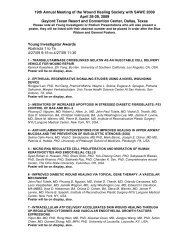

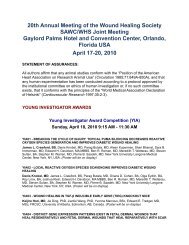
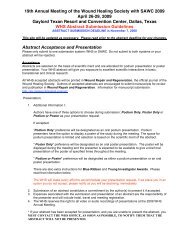
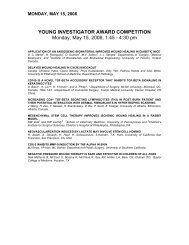

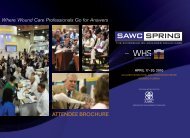

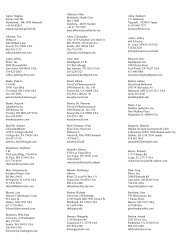
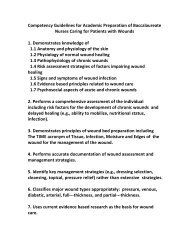
![2010 Abstracts-pah[2] - Wound Healing Society](https://img.yumpu.com/3748463/1/190x245/2010-abstracts-pah2-wound-healing-society.jpg?quality=85)